Dick Butler (DB) has test flown Concordia and is delighted with the ship’s handling. In June and July, Dick will be busy flight testing, tuning the glider, and practicing for this summer’s WGC in Uvalde, TX. He has limited time to provide updates; however, the Café will post an occasional photo as flight testing proceeds.
[Note: clicking on an image will open a “lightbox” to view the images with. Also, you can use the left and right arrow keys to navigate from either view.]
The Soaring Café provided the original series on Concordia, which began in January, 2011. In that post, we provide a chronologically ordered series of links to Soaring Café articles that comprise a complete history of the project, from conception to the current status of Concordia in the build (and later flight testing) phase. Most of the articles were written by chief designer and builder Dick Butler himself. All of the Soaring Cafe Concordia story has now been migrated to this site.



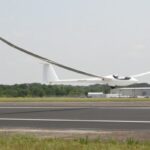
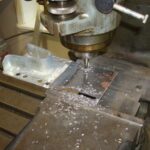
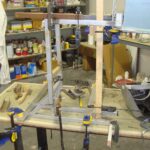
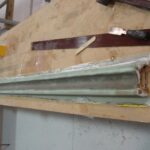
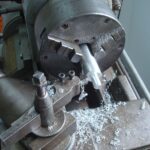
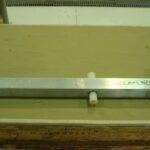


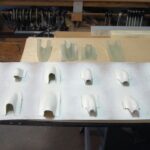
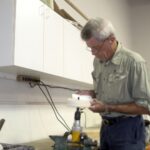
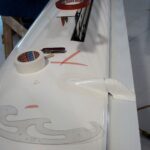
American masterpiece…
american ?
Please expand on the finish of the flaps, ailerons, and rudder. It is not intented for these parts to have a gelcoat finish?
The actual MonoKote shrink film is very unstable to humidity and temperature changes; it can be shrunk tight as a drum in the shade and will wrinkle after a few minutes in the sun. I cannot imagine it ever being suitable for the “racer’s edge”.
Ben,
Actually, the control surfaces are being covered with SolarTrim, which has a number of advantages over monokote and is a very lightweight material compared to gel coat or paint, so it adds very little weight to Concordia. For details, see my interview with Chris Woodward, who chose the material and is applying it to the Concordia control surfaces in Dick’s workshop as I write.
I have discussed this with DB and the reason for using MonoKote (actually a similar film, not MonoKote) is to reduce the weight of the control surfaces and thus the required lead (or tungsten) to counter balance the control surfaces. And, with such a long tailboom, keeping the weight down in the tail reduces the potential need for weight in the nose to manage the CG.
My personal experience with MonoKote applied to flat solid surfaces is that it does not wrinkle in the sun — but, I do have a limited experience.
GO AHEAD CONCORDIA TEAM !!!!
I HOPE THE BEST FOR ALL YOU
JUAN MARIO
Thanks for sharing the pics. It has been a pleasure to see how much work really goes into making a bird/ship/dream machine. Many facets of the building process were unknown to me until seeing these pictures.
Best of luck, I’m really looking forward to seeing those long skinny wings with some airloads on them 🙂
Hello Ben,
to use airplane model coating instead of relatively heavy gel coat is a relatively old idea of mine.
I hope, Dick was lucky in choosing the foil that is used now.
A white coating of any epoxy structure is necessary for UV protection and to provide an aerodynamically slippery surface for the turbulent boundary layer is needed on the wing trailing edge controls.
In the meantime I have seen UL aircraft “painted” with self adhesive foils as well as (removable) foils applied to car surfaces. All our German police cars are “painted” with such foils . When removed they can be sold on the second hand market.
Concordia will live most of its time inside the hangar and inside its trailer and sun exposure and weathering will not be much more than a model airplane.
In case you know more on the subject, let us know via Soaringcafe or directly.
Yours,
Gerhard
Dear Concordia Team,
do you know of any meaningful measurements regarding the UV transmissivity of solartrim. As it is so thin, I am wondering if there are numbers to see if there is residual fluy reaching the epoxy and thus leading to a long term degradation. Otherwise I think it is a very clever idea…..
All the best
Elias
Reply from Chris Woodward [who installed Solartrim on Concordia]: “My opinion is that Solartrim is okay for Concordia because it is an unlimited race plane. It will see very limited UV exposure during racing events.
The white covering was mainly to improve airflow and reduce temperatures. A major concern for Concordia was the total maximum allowed weight of the surface due to the minimal room to counter-balance the surface.
Most plastics have excellent UV aborptance and reflectance. That sacrifice is what causes the plastics to ‘age.’
If this technique were used on production aircraft, UV would definitely be a consideration. The Solar Impulse aircraft is using a German R/C covering by Oracover, which also sells a covering for ultralight aircraft. http://www.solarimpulse.com .”
Why not cover the entire wing in the material if it’s that much lighter?
because it is not necessary to reduce the weight of the entire wing, only the weight of the flaps and ailerons, because of mass balance issues. mass balancing the control surfaces at the hinge point is done to manage flutter. and there isn’t much room for weight inside of where the nose of the aileron fits. it is being done to the rudder as well, because the station of the rudder is so far aft, and that needs to be mass balanced as well.
The wings were profiled to true using gelcoat. Can’t do that with film.
Is there any reason why the wing is made in 3 pieces? It seems to me that a 28m span ship could have just 2 x 7m panels per side and still fit in a normal sized trailer which would eradicate one of your wing joins and save a load of weight?
Kai
Kai,
Here’s a reply to your question from Gerhard Waibel:
“Seven meter span inner wing panels get too heavy, so dividing the wings about in the spanwise c.g.- position results in two panels of about the same weight.
As the outer panel then gets too long, a detachable wing tip is the solution.
In retrospect Dick and I were happy to do so, as the separate tips allowed to attach them with extra dihedral in order to get wingtip clearance for takeoff with a full water load inside the wings.
Best regards,
Gerhard
[Comment imported from SoaringCafe.com]
Bill, Rand
What measures, if any, have been made to address Uvalde-grade
ventilation ? Thanks.
And thanks for the great job of keeping us informed !
Reply from Gerhard Waibel:
Dear Fred,
CONCORDIA- cockpit was built in ASW 27 fuselage molds; however with stronger wall laminates.
As venilation intake and sidewall (cockpit sill) ventilation ducts are the same as ASW 27, ventilation should be like ASW 27, ASG 29 and so on. You can be sure that Dick will find a clever ventilation exit, which is the second half of the ventilation problem.
Kind regards,
Gerhard
The “tracks” that were formed to contour leading edge seem to be spaced about 6 feet apart. This means you have to use a long straight edge from track to track. Does this not create a problem with the flex in the straight edge causing an error in the area half way between tracks?
I know you guys are really busy, and work comes first. If you have time to answer that would be great.
I am addicted to the concordia project and check in here 2 times a day
The long sanding bar used is stiff enough to stay straight while spanning between the “ribs”. Commonly it does not have abrasive right where it slides on the ribs.
Hope this makes sense to you.
UH
Reply from Gerhard Waibel
Dear David,
how to make a straight leading edge nose between 0,6 m wide tracks is a pice of art.
Heinzi Weissenbuehler and Dick Butler *know how *to do this and I got a good lesson from Rudy Mozer of DELTA MODEL. However before that we were already quite sucessful in making the D34d-wing and the D36 at Akaflieg Darmstadt, the ASW 12,15 17, 19, 20, 22, 24 and 27 molds without CNC cutting.
You may not believe this as young people, but perfect workers are as good as a CNC-mill.
However the CNC cutting is ceaper today and the art may be lost.
Any more questions? What about repair of sailplanes ? You see, why they are so expensive.
Kindly yours,
Gerhard Waibel
[Comment imported from SoaringCafe.com]
[Comment imported from SoaringCafe.com]
[Comment imported from SoaringCafe.com]
[Comment imported from SoaringCafe.com]
[Comment imported from SoaringCafe.com]
It occurs to me that model aircraft do not experience low temperatures as a Concordia will at high altitude.
Just a thought that it might be wise to put one of the control surfaces in a cold chamber to make sure the film doesn’t split.
Although the material on its own is probably OK, it might come under a lot of tension through differential expansion coefficients.
Fascinating project – Dick, I hope you get some R&R before the comp.
[Comment imported from SoaringCafe.com]
[Comment imported from SoaringCafe.com]
[Comment imported from SoaringCafe.com]
Interesting wing storage in the Cobra. So are the middle wing panels stored in the boxes? And if so, what is the reason for encasing them in a box?
Given the current progress, what is DB’s estimate for first flight?
[Comment imported from SoaringCafe.com]
[Comment imported from SoaringCafe.com]
[Comment imported from SoaringCafe.com]
[Comment imported from SoaringCafe.com]
[Comment imported from SoaringCafe.com]
[Comment imported from SoaringCafe.com]
[Comment imported from SoaringCafe.com]
This is such a great project, and it’s great that you’re sharing all your hard work in the photo diary and articles. Best of luck at Uvalde!
Afandi
Wow!
IMPRESSIVE!!!!
Supership!
Paraphrasing the old saying, to wit: If it looks like it will fly great, then this beautifully sculpted soaring machine will exceed the sculptor’s loftiest dreams…
Truly, a magnificent accomplishment.
Congratulations!
Wow!. THINFOS!
Wow this last picture is amazing!
Isn’t she a true beauty? Congratulations team DB. I’ve been a great and staunch admirer of you concerted effort ever since chancing upon the Concordia project at soaringcafe a year ago, and devouring every article, post and picture on your supership. Though only a hobby model pilot, being German by birth and an airplane enthusiast, one cannot help but being into gliders. Living in South-East Asia for the past 25 years, I wish my circumstances would allow for a trip to the US and observe first-hand the flight tests (and perhaps the Uvalde comps). With this leading-edge glider it certainly would be more than worth my while. Meanwhile my heart is burning for more updates – pics and articles. Nothing since May 1st!!! Has the testing begun? When will we get news?
Best of luck team DB for the road ahead. Thanks a lot for creating so much excitement and passion.
When will the Concordia saga continue?